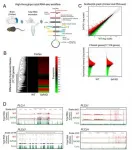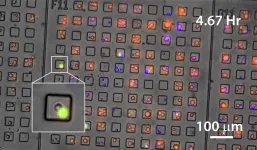(Press-News.org) Major changes in bereavement care have occurred during the COVID-19 pandemic, amid a flood of demand for help from bereaved people, according to new research from the University of Cambridge. The first major study of pandemic-related changes in bereavement care has found that the switch to remote working has helped some services to reach out, but many practitioners feel they do not have capacity to meet people's needs.
It is estimated that for every death, nine people are affected by bereavement. The scale of the impact of the COVID-19 pandemic on those bereaved is now becoming apparent, whether the death was from COVID or from other causes.
Those whose loved ones have died with COVID-19 have had to cope with sudden and unexpected death, deaths in intensive care units, and with seeing loved ones suffer severe symptoms including breathlessness and agitation at the end of life. Social distancing measures have meant restricted visiting at the end of life, leaving some to die alone. Viewing the deceased person's body and funeral proceedings have been severely curtailed, with major impact on those bereaved from all causes, not only from COVID-19. All these factors mean that the risks of complicated and prolonged grief responses have become higher during the pandemic.
In research published today in BMJ Open, researchers at Cambridge's Department of Public Health and Primary Care report the results of an online survey sent to health and social care staff in August 2020, inviting them to describe their experiences and views about changes in bereavement care. 805 people responded, including those working in community, care home, hospital and hospice settings across the UK and Ireland.
Services faced initial challenges adapting to changing national government guidelines. Some bereavement services were suspended due to staff being furloughed or redeployed, particularly specialist bereavement services. Volunteer support in hospitals and hospices was reduced and some services saw increased waiting lists.
"We had 600% increase in deaths for a 3-week period. Dealing with the backlog of bereavement support was challenging," said one palliative medicine doctor.
Bereavement care fell to a wider range of staff members, including some with limited experience. Some people reported that services were under-resourced before the pandemic and that the pandemic would worsen the situation and add new difficulties due to the complex grief reactions.
The biggest change has been the switch to remote methods of providing support - such as telephone and video - which was reported by 90% of respondents. Adapting care to online or telephone formats was particularly challenging, with limited access to the equipment needed and limited staff training in their use.
The move to remote support has been a double-edged sword. On one hand, it increased some opportunities for bereavement support. Services supporting children and young people at times reported these groups to be more receptive to online support and hospices and hospital teams reported widening access to their bereavement support. However, practitioners described the remote work as "draining" and difficult to manage, alongside their own emotional strains during the pandemic.
Some practitioners feared being overwhelmed by demand: "We are really only seeing those who have been bereaved in Jan/Feb so far, so there may be many more to come," said one Community Listening Service Coordinator.
The changes to services were reported to have disrupted the ability to offer emotional support: "It has felt as though we are dealing with them at arm's length whereas we would be there to hold their hands, give them a hug as needed," said a palliative medicine doctor.
Many respondents expressed grave concerns over the long-term impacts on bereaved people, highlighting the inability or restrictions on being with the dying patient as having a profound impact in bereavement.
"Many people who died were denied opportunity to die in their preferred place of care / preferred place of death and died in suboptimal environments to receive their care in last days," said a GP.
While those bereaved from COVID-19 and non-COVID conditions were similarly affected by the restrictions, specific challenges related to COVID-19 were reported. Some respondents described relatives' anger at having COVID-19 on the death certificate. One Bereavement Specialist Liaison Nurse said that the disease "seemed to have a 'stigma' for some". This sense of stigma was thought to exacerbate peoples' feelings of having failed to protect their family member from COVID-19.
Concerns were raised over a large and 'invisible cohort of people' who may not access support or for whom support will be restricted, leading to greater unmet need. "There may be a silent epidemic of grief that we have not yet picked up on," said a Palliative Medicine Doctor.
Dr Caroline Pearce, the lead researcher, said: "Bereavement care has undergone major changes in both acute and community settings affecting bereaved people, clinicians, support workers and the wider health and social care system. The increased need for bereavement care has challenged practitioners as they have taken on new responsibilities and skills and shifted to remote and electronic working. The increased potential for prolonged and complicated grief responses among those bereaved during this period is particularly concerning."
Andy Langford, Clinical Director, CRUSE Bereavement Care, added: "Speaking about grief remains an area of public discomfort, and it is important practitioners encourage bereaved people to view grief as a 'valid' reason to seek help from health and community services, as well as from those they trust in their communities. It was heartening that many respondents reported the development of new and expanded services, but it is imperative that these are made sustainable in the longer-term. The need isn't going away."
INFORMATION:
This study was funded by National Institute of Health Research, School for Primary Care Research.
Reference
Pearce, C et al. 'A silent epidemic of grief': a survey of bereavement care provision in the UK and Ireland during the COVID-19 pandemic. BMJ Open; 1 March 2021; DOI: 10.1136/bmjopen-2020-046872
MINNEAPOLIS - Obstructive sleep apnea is when breathing is repeatedly interrupted during sleep. Research has shown people with this sleep disorder have an increased risk of developing cognitive impairment and Alzheimer's disease. Yet, it is treatable. A preliminary study released today, February 28, 2021, has found that obstructive sleep apnea is common in people with cognitive impairment. The study will be presented at the American Academy of Neurology's 73rd Annual Meeting being held virtually April 17 to 22, 2021.
Cognitive impairment includes memory and thinking problems that affect ...
Red supergiants are a class of star that end their lives in supernova explosions. Their lifecycles are not fully understood, partly due to difficulties in measuring their temperatures. For the first time, astronomers develop an accurate method to determine the surface temperatures of red supergiants.
Stars come in a wide range of sizes, masses and compositions. Our sun is considered a relatively small specimen, especially when compared to something like Betelgeuse which is known as a red supergiant. Red supergiants are stars over nine times the mass of our sun, and all this mass means that when they die they do so with extreme ferocity in an enormous explosion known as a supernova, in particular what is known as a Type-II supernova.
Type II supernovae seed the cosmos with elements ...
Tokyo, Japan - Researchers from Tokyo Metropolitan University have revealed how liquid foams collapse by observing individual collapse "events" with high-speed video microscopy. They found that cracks in films led to a receding liquid front which sweeps up the original film border, inverts its shape, and releases a droplet which hits and breaks other films. Their observations and physical model provide key insights into how to make foams more or less resistant to collapse.
Understanding how foams collapse is serious business. Whether it's ensuring fire extinguishing foams stay long enough to put out flames, cleaning up toxic foams in seas and rivers, or simply getting the perfect rise on a cake, getting to grips with how foam materials collapse is vital to tailoring their properties, ...
Korea Brain Research Institute (KBRI, President Suh Pann-ghill) announced that the research team led by Dr. Jae-Yeol Joo discovered new cryptic splice variants and SNVs in PLCg1 gene of AD-specific models for the first time using Splice-AI.
This research outcome was published in PNAS, a world-renowned academic journal.
* (Title) Prediction of Alzheimer's Disease-Specific phospholipase c gamma-1 SNV by Deep Learning-Based Approach for High-Throughput Screening
Alternative splicing variant regulates gene expression and influences diverse phenotypes. Especially, genetic ...
Marine protected areas (MPAs) around O?ahu do not adequately protect populations of herbivorous reef fishes that eat algae on coral reefs. That is the primary conclusion of a study published in Coral Reefs by researchers from the University of Hawai?i at Mānoa School of Ocean and Earth Science and Technology (SOEST).
There are over 20 species of herbivorous fishes and ten species of herbivorous urchins commonly observed on Hawaiian reefs. These species eat algae that grows on reefs, a process called herbivory, that contributes to the resilience of coral reefs by preventing algae dominance that can lead to overgrowth of corals.
The team of researchers found that of the four marine protected areas around O?ahu they assessed in the study, ...
The ability to read is foundational to education, but prolonged school closures and distance learning due to the pandemic have imposed unique challenges on the teaching of many fundamental skills. When in-person classes resume, many students will likely need a period of catch-up learning, especially those who lag behind in basic reading skills.
New research published in the journal Psychological Science shows that people who were taught to read by receiving explicit instructions on the relationship between sounds and spelling experienced a dramatic improvement compared to learners who discovered this relationship naturally through the reading process. These results contribute to an ongoing debate about how best to teach children to ...
New research from Baylor College of Medicine scientists shows that a combination of deep brain stimulation (DBS) and exercise has potential benefits for treating ataxia, a rare genetic neurodegenerative disease characterized by progressive irreversible problems with movement.
Working with a mouse model of the human condition, researchers at Baylor and the Jan and Dan Duncan Neurological Research Institute at Texas Children's Hospital discovered that combining DBS targeted to the cerebellum, a major motor center in the brain, and exercise rescued limb coordination and stepping and that the benefits persisted without further stimulation. In addition, the study reports that stimulating mice with early-stage ataxia showed the most dramatic improvements. These and other ...
BOSTON -- Billions of peripheral white blood cells are produced every day by the regular divisions of hematopoietic stem cells and their descendants in the bone marrow. Under normal circumstances, thousands of stem cells contribute progeny to the blood at any given time, making white blood cells a group with diverse ancestry.
Clonal hematopoiesis is a common age-related condition in which the descendants of one of these hematopoietic stem cells begin to dominate substantial portions of the blood. Genome-wide analyses have determined that clonal ...
COLUMBIA, Mo. - While physical activity is important for everyone, research has shown people with developmental disabilities do not exercise as often as their typically developed peers. In an effort to close this disparity, a researcher at the University of Missouri recently created fitness picture books that help youth with autism exercise more frequently while offering low-income families a simple resource for workout motivation when outdoor fitness equipment might not be accessible.
"There is so much research geared toward helping individuals with autism improve their academic ...
Treatments for beating tumours are mainly based on CD8 T lymphocytes, which specialise in detecting and eliminating intracellular infections and in killing cancer cells. A large proportion of patients, however, do not respond to these treatments. This prompted a research team from the Swiss Cancer Centre Léman (SCCL, Switzerland) to bring together the universities of Geneva (UNIGE) and Lausanne (UNIL), the Ludwig Institute for Cancer Research (LICR), EPFL and CHUV to investigate CD4 T lymphocytes. While these play a supporting role with CD8 T cells, their ability to eliminate tumour cells directly has been a matter of controversy. Using innovative nanoimaging technologies designed at the EPFL laboratory, the scientists found that when the CD4 T lymphocytes ...





